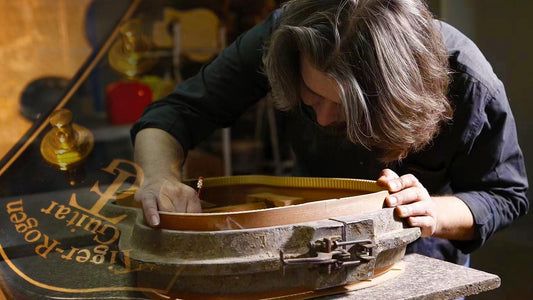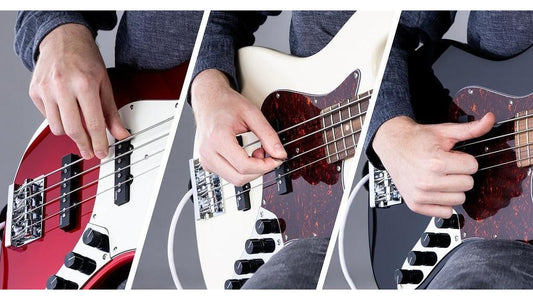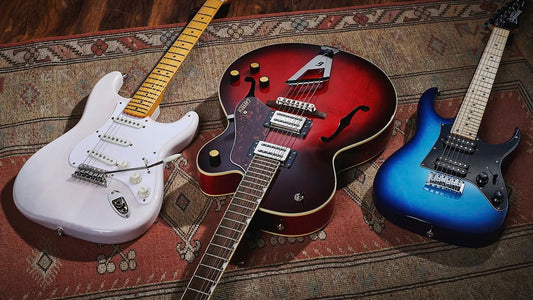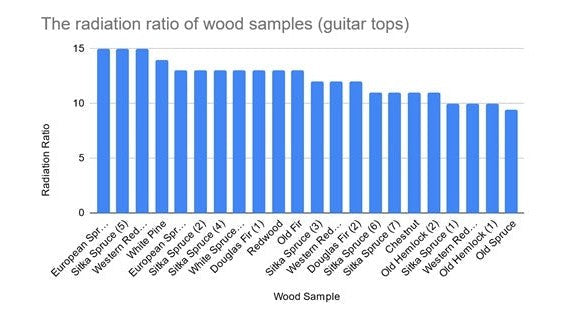
Tại Sao Đàn Guitar Thường Được Làm Từ Gỗ Vân Sam và Tuyết Tùng
Những cây đàn guitar thùng tốt nhất trên thế giới trong lịch sử được làm từ các loại gỗ cao cấp, chẳng hạn như vân sam, tuyết tùng và gỗ rosewood. Điều này là do truyền thống hay đã được chứng minh bởi khoa học?
Một phần của câu trả lời nằm ở các đặc tính của gỗ. Một nghiên cứu toàn diện được thực hiện vào cuối những năm 1970 đã đánh giá 25 loài gỗ (trên 87 mẫu gỗ) đã được sử dụng để chế tạo các nhạc cụ chất lượng cao bao gồm guitar, violin và piano. Theo bài báo của Daniel W Haines, On Musical Instrument Wood.
“Gỗ Phong phù hợp cho lưng đàn violin cũng như gỗ Rosewood phù hợp với lưng đàn guitar. Truyền thống làm phong phú thêm về cách thức làm đàn khi bổ sung thêm: cách gỗ được cắt từ cây và sở thích riêng đối với các loại gỗ. Tại sao lại thế? Chúng tôi tin rằng câu trả lời nằm ở một số đặc tính cơ học liên quan đến âm nhạc của những loại gỗ này, cụ thể là độ cứng, mật độ và giảm chấn dao động." Haines đã kết hợp các thuộc tính gỗ này thành chỉ số Độ ồn (L), chỉ số này cho biết tiềm năng tạo ra độ to lớn hơn.
“Mật độ thấp, mô-đun Young cao [độ cứng của gỗ] và độ giảm chấn thấp góp phần tạo nên giá trị L cao”. Giá trị L đo lường hiệu quả các đặc tính của gỗ ở một mức độ cộng hưởng nhất định. Tiến sĩ Bernard Richardson của Đại học Cardiff tiếp tục nghiên cứu các đặc tính của gỗ ngày nay và cho biết biện pháp này có một số hạn chế.
Ông cho biết Tỷ lệ bức xạ - một thước đo khác của công suất âm trừ tác động của giảm chấn - là một thước đo tốt hơn về các đặc tính của gỗ. Tỷ lệ này (về mặt kỹ thuật là thước đo tỷ lệ độ cứng và tỷ trọng) mô tả rõ hơn sự kết hợp của các chế độ trong bức xạ âm thanh trên tần số cộng hưởng của chúng.
Biểu đồ dưới đây cho thấy Tỷ lệ bức xạ của một số mẫu gỗ được sử dụng để làm đàn guitar (và vĩ cầm) do Haines thử nghiệm. Nó cho thấy một số loại gỗ phổ biến như Vân sam châu Âu và Tuyết Tùng đỏ phương Tây, được xếp hạng đặc biệt cao, mặc dù có sự khác biệt lớn giữa các mẫu.
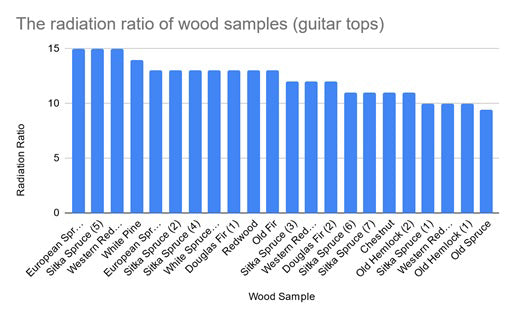
Vân sam và tuyết tùng: tỷ lệ bức xạ mạnh
Có nhiều loại vân sam khác nhau, nhưng Haines gọi Vân sam châu Âu là sự lựa chọn hàng đầu của các nhà sản xuất nhạc cụ (mà ông gọi là Picea excelsa - một thuật ngữ khoa học hiện đã lỗi thời, được thay thế bằng Picea abies).
“Loại gỗ này thường có hạt mịn, màu sáng và được ưa chuộng bởi các nhà sản xuất nhạc cụ hơn so với các loài vân sam khác,” theo báo cáo của Haines.
Tỷ lệ bức xạ đối với một mẫu Vân sam Châu Âu cao bằng bất kỳ mẫu nào trong số 87 mẫu được Haines thử nghiệm, nó cũng phù hợp với các mẫu của Sitka Spruce và Western Red Cedar.
“Những người thích Tuyết Tùng hiểu được tầm quan trọng của nó vào chất lượng âm thanh, vì nó dễ tách và lõm. So với Vân Sam, loại gỗ này ít đặc hơn, ít cứng hơn và đáng kể nhất là ít bị ẩm”. Mặt lưng của đàn guitar theo truyền thống được làm từ gỗ Rosewood, khác với đàn vĩ cầm, được làm từ gỗ Thích.
Haines cho rằng sự lựa chọn này là do chất lượng giảm chấn của gỗ Rosewood thấp hơn so với gỗ Thích. Điều này giúp cải thiện độ bền của cây đàn guitar, vốn ngược lại với violin.
Haines có thể đã phóng đại hóa trường hợp này. Sự truyền năng lượng từ dây đến thân của cây đàn guitar là yếu tố hạn chế trong việc mất năng lượng và chính sự mất của dây đàn mới là yếu tố chính, đặc biệt là ở tần số cao hơn.
Chất lượng âm thanh không chỉ là một chức năng của các loài gỗ
Loại gỗ được sử dụng để làm nhạc cụ không đi đôi với âm thanh tuyệt vời, thậm chí nó sẽ có một giai điệu riêng. Có quá nhiều yếu tố tác động, ngay cả trong cùng một loài gỗ, và trong việc chế tạo đàn guitar.
Luthier Trevor Gore đã ước tính rằng các đặc tính vật liệu của gỗ từ cùng một loài có thể thay đổi theo hệ số hai. “Do đó, có sự trùng lặp đáng kể về các đặc tính vật liệu của một loài này với các loài khác, ngụ ý rằng có thể thay thế các loài gỗ với ít tác động âm thanh nếu thành phần được thiết kế và chế tạo theo dung sai âm thay vì dung sai kích thước,” ông viết trong một bài báo, Wood for Guitars, được xuất bản trên Tạp chí của Hiệp hội Âm học Hoa Kỳ. Điều này được phản ánh một phần trong các bài kiểm tra của Haines. Ví dụ, một mẫu Vân sam châu Âu có Tỷ lệ bức xạ là 15 trong khi một mẫu khác (được sử dụng để làm đầu vĩ cầm) chỉ dừng ở mức 10.
Haines suy đoán rằng gỗ có hiệu suất kém hơn là do các vân trong mẫu (gợn sóng trong sợi gỗ), điều này có thể làm tăng mật độ của gỗ (và giảm xóc bên trong, phản ánh trong giá trị Độ ồn thấp hơn). Tiến sĩ Richardson hiện đang thử nghiệm gỗ Tuyết Tùng và Vân Sam trọng lượng nhẹ, cho những đặc điểm tương tự. “Tôi nghi ngờ sự khác biệt sau đó trở nên khá nhỏ,” anh nói. "Điều quan trọng là các đặc điểm vật lý thực sự - không phải loài."
Trong khi miếng Tuyết Tùng trung bình ở cấp độ tế bào có thành mỏng hơn, dẫn đến mật độ và độ cứng ít hơn (mật độ là yếu tố chính), những khác biệt chung này có thể dễ dàng thay đổi. “Tôi đã có những mẫu cây Vân Sam được cắt kỹ với mật độ thấp hơn cây Tuyết Tùng - đó chỉ là một điều kỳ lạ về cách chúng đã phát triển.”
Những khác biệt khác được tìm thấy giữa cùng một loài gỗ bao gồm kích thước thớ, có thể thay đổi tùy thuộc vào khu vực nơi gỗ được trồng và mật độ. Theo Haines, mật độ của gỗ vào mùa hè sẫm hoặc vòng sinh trưởng của gỗ muộn cao hơn nhiều so với mật độ của gỗ sáng sớm vào đầu mùa xuân.
Cách cắt gỗ cũng có ảnh hưởng đáng kể đến tính chất âm học của nó. Theo Tiến sĩ Richardson, cách truyền thống để cắt gỗ là kiểu cắt một phần tư, giữ cho thớ và sợi thẳng nhất có thể để tối đa hóa độ cứng. Điều này tối đa hóa khẩu phần bức xạ cho gỗ đã chọn (bất kể loài nào).
Ông nói: “Rất hiếm khi tìm thấy những cây Vân Sam mọc mà không phát triển theo hình xoắn ốc, vì vậy rất khó để có được một tấm gỗ có chiều rộng đầy đủ được xếp thành từng phần trên toàn bộ chiều rộng của nó hoặc có các sợi chạy song song với các mặt trên toàn bộ chiều rộng. Luôn có những thỏa hiệp trong loại gỗ được xử lý tốt nhất - và những thỏa hiệp thậm chí còn lớn hơn trong hầu hết các loại gỗ được cắt ra nhằm tối đa hóa lợi ích thương mại, hơn là tiêu chí âm thanh.”
